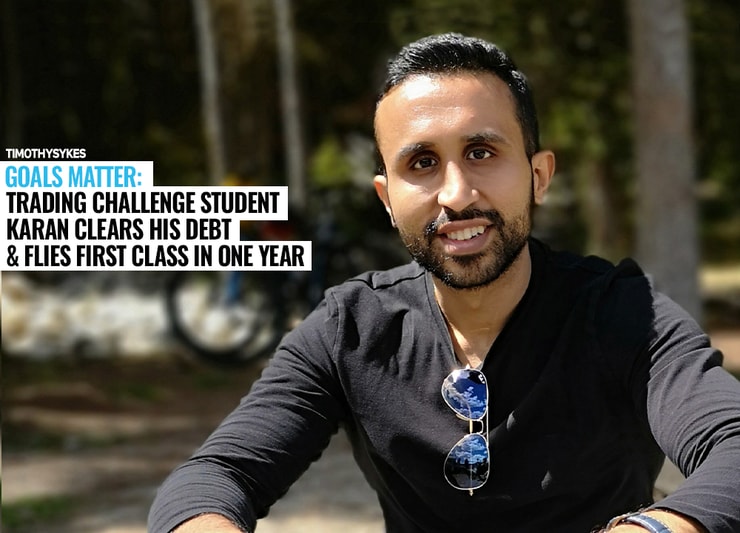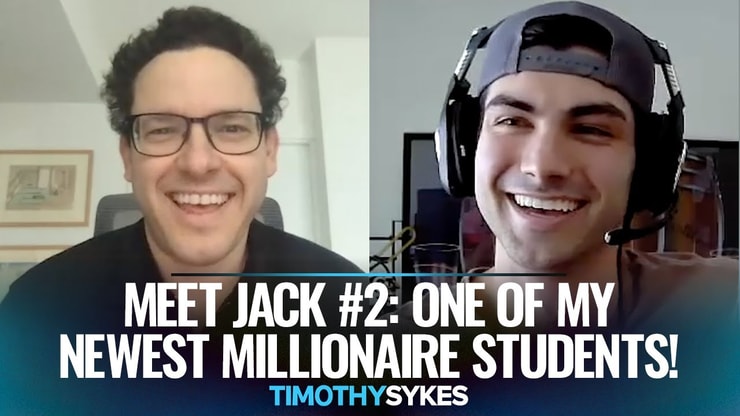Update on Challenge Student Karan: Key Takeaways
- See how Karan’s been upping his game since the first time I featured him…
- This student proves you don’t have to win every trade to be successful. Check out his latest stats!
- He’s hit a big milestone, but his goals remain the same…
ALL My Top Students Hone Their Trading Strategies Here
My student Karan has been in the Trading Challenge since 2017. He’s been trading since 2020…
This year, he’s erased his debt and gone exponential.
Those are some amazing goals to hit! Today we’ll cover how Karan did it.
Table of Contents
From Flat Broke to First Class
In 2017, Karan realized something needed to change. He’d been working hard his whole life. But he still found himself behind, hitting a wall and getting nowhere.
Then he enrolled in the Trading Challenge.
In order to pay my debts plus student loans off I needed to figure a way to make more money. I landed across @timothysykes and decided to take on another 7k debt to study and learn how to make money in the markets. In the year 2019 I was in NYC visiting a friend
— Karan Khanna (@karanakhanna25) September 25, 2021
He borrowed $2,500 to get started trading. Guess what? He’s grown that initial stake more than 100-fold.
While visiting him I landed a pretty high paying corporate job and also kept pushing to learn the markets. In the year 2020, I borrowed 2500 from a friend to start trading as all my paycheques were going into paying off my debt. Fast forward a year and half later
— Karan Khanna (@karanakhanna25) September 25, 2021
I managed to clear off all my debt. Have more than 200k of liquid cash at my disposal, most of it came from the markets and some from my day job savings. And I just booked my first first class plane ticket to travel from NYC to LA.
— Karan Khanna (@karanakhanna25) September 25, 2021
Karan managed to go from more than $1,000 underwater to $268,000 in profits…
He wiped out his $60,000 debt at the end of 2020. By the end of 2021, he managed to book a first-class ticket on a plane.
This isn’t a game. We’re not trying to stack first-class tickets and other luxury items. Karan isn’t in this for the comfy seat and champagne.
He’s in it to make his goals come true.
The First Step: Having a Goal
It’s easy to miss the importance of goal-setting. You likely trade because you want to make money. Just like everyone else in the market.
Karan’s drive comes from the fact that he knew exactly how much he had to make. He needed $60,000 to clear his debt…
Since he did that, he’s now focused on the $1 million mark. Until he hits that, he’ll be trading AND working his day job.
Karan celebrated hitting the quarter-million mark by making his travel more comfortable. He wanted to spend those flight hours locked into the market.
Like most of my top students, he didn’t buy a flashy car when he hit his milestone.
Instead, he doubled down on his commitment.
What Changed Since Our Last Check In?
I wrote about Karan earlier this year. He hadn’t crossed $100,000 yet. But he was already taking strides.
On June 30, 2020, he had his biggest trading day yet — more than $17,000 in profits. It wasn’t a random trade. He’d been tracking CytoDyn Inc (OTCQB: CYDY) for days.
He followed my 7-step pennystocking framework to catch the stock on both sides. He shorted it off its highs, then caught it on the bounce.
His two biggest trades on CYDY were for $13,467 and $3,130. (BTW, I made $23,220 longing CYDY the same day!)
This is where Karan’s aggressiveness paid off. It was a pump in one of the hottest sectors during one of the hottest markets I’ve ever seen…
Almost everything worked out for him on that BIG day. But things working out isn’t a sound strategy. Karan discovered that about a month later…
On August 3, 2020, Karan had his biggest loss of the year.
He shorted Grayscale Digital Large Units (OTCQX: GDLC), a fund heavily invested in crypto.
This was at the start of bitcoin’s stimulus-fueled come-up. I always warn traders about shorting…
But Karan picked an especially bad time to short what was about to become the market’s hottest sector. Karan ended up losing $8,337 on the play.
The trade conditions were good. It was a third green day. The stock was already overextended…
But Karan broke a key role of shorting — GDLC was trading under a million shares. When the squeeze happened, he had no way to cover.
He was down $35,000 at one point in the trade. He almost blew up his account.
He got out on a pullback. He was lucky again. The stock made it into the high $50s before its run ended.
More Breaking News
- Richtech Robotics’ Roller Coaster Ride: Buy or Hold?
- AppLovin Stock Soars: Buy or Just Curious?
- Archer Aviation’s Recent Swoop: What’s Next?
What Going Exponential Looks Like
Karan doesn’t rely on luck anymore.
He sizes in small when he’s testing a theory. He scales into trades that are working and bails on trades that aren’t.
As for the temptation of low volume stocks? He tweaked his stock screener. Unless a stock reaches sufficient volume, it won’t even show up on his radar.
He’s traded in the big swings for small gains. And like I always say, small gains add up.
Here's your daily reminder that SMALL GAINS ADD UP OVER TIME! And compounding growth week over week, month over month, year over year is SO powerful despite being disrespected by too many people worldwide! Please retweet/favorite this & help me get more people to understand this! pic.twitter.com/6lH7fjLI0w
— Timothy Sykes (@timothysykes) April 18, 2021
From mid-October to mid-December, Karan’s up more than $65,000. He’s a FANATIC about managing risk.
It was his biggest weakness when he started. He knew which setups he liked. He would make money when they worked. And he’d lose money when they didn’t.
He was like a boxer going punch for punch. Not a winning strategy.
Now, even when Karan takes a loss — like this $17,000 loss on AMC — it’s a planned loss.
He was trading AMC as it bounced around a range. He knew the risks. He had set a risk of $20,000 on that trade.
But that’s not the whole story. Karan tallied gains of $4,564, $4,144, $3,663, $2,390, and $4,881 on AMC trades the SAME DAY.
Say it with me: small gains add up.
The ‘Papercuts’ Theory
Karan loses more trades than he wins. That’s OK. He knows when to get out.
He calls this strategy ‘taking papercuts.’
He’ll try a trade idea with small size. If he’s in too early, he’ll take a small loss. If it doesn’t work, he’s out.
He might go back to the same idea later. Karan’s not playing bad setups. He’s just giving himself as many bites of the apple as he needs…
No one can predict the markets. The way Karan’s built that unpredictability into a working strategy is by managing his risk.
He’s become a master at cutting losses.
This is how he leveraged a 44% win rate into a winning strategy.
“I stopped tracking my winning percentage,” Karan says. “Initially I was obsessed, but it hindered my trading. I wanted to be right all the time.”
This is a message I want all traders to hear. Good trading isn’t about winning.
“I really don’t care about my winning percentage at this point,” Karan says. “All I care about is how I’m executing my trades.”
What Karan Gets Out of My Trading Challenge
Like most of my top students, Karan put in the work.
This tweet was in response to a midnight study check I put out.
Been going over my trades, trying to see how can i improve, working on my risk management and tracking some more data.
Studying is the key to success. Having a marathon mindset is key.
Started the year with $2500 and grew it to over 30K now.
Thanks a lot @timothysykes pic.twitter.com/UNYRE8h4Jy— Karan Khanna (@karanakhanna25) July 4, 2020
He isn’t resting on his laurels. Karan is after constant improvement.
Before he started trading seriously, Karan hit the books. Or rather, the 7,000+ video lessons accessible through my Trading Challenge. Plus, the weekly sessions with millionaire traders. And the best chat room on the planet.
Like Karan says, “Even if you just show up and watch that chat, it will teach you more in a short time than going over hours and hours of study material.”
In the beginning, he studied 12–14 hours some days. He’s still putting the time in. And now it’s paying off for him.
Join Karan and other top traders in my Trading Challenge — apply here.
Karan’s Advice to New Traders
Karan has honed his trading strategy to a highly technical level.
But his strategy comes down to some common-sense points. Here’s how he breaks it down:
- Understand how the algos work. “Don’t buy the high-of-day break into strength on listed stocks. Algos are looking for liquidity zones, and those are the main liquidity zones. Wait for the stock to dip, wait for it to hold. Then buy into the trade.”
- Don’t chase strength. “If you’re buying, buy on a red candle. If you’re shorting, short on a green candle.”
- Look at longer time frames. “Don’t draw trends on one- or five-minute candles. Use 15 or 30 minutes. Let the chart develop before you get in a trade.”
- Don’t get into a stock right at the open. “Once you’ve let the chart develop, once you understand how much volume it’s going to trade, you can make a good decision.”
- Understand the psychology of a pattern. “If you can say that this pattern is happening because shorts are doing X, longs are doing Y, and this is the reason why this pattern is forming, you can come up with more variances on that pattern.”
What’s Next?
Karan’s working on adding more weapons to his arsenal. First up is the gap and crap.
This pattern is cousin to ‘buy the rumor, sell the news.’ It describes a stock that gaps up overnight on good news … Then it falls apart at the open.
Karan is just dipping his toe into this pattern, trading small size for now.
This is how good traders improve their game. With the progress Karan has already made, I’m guessing he’ll be up to speed in no time!
What have you learned from Karan’s journey? What can you put to work for YOU today? Let me know in the comments!












Leave a reply